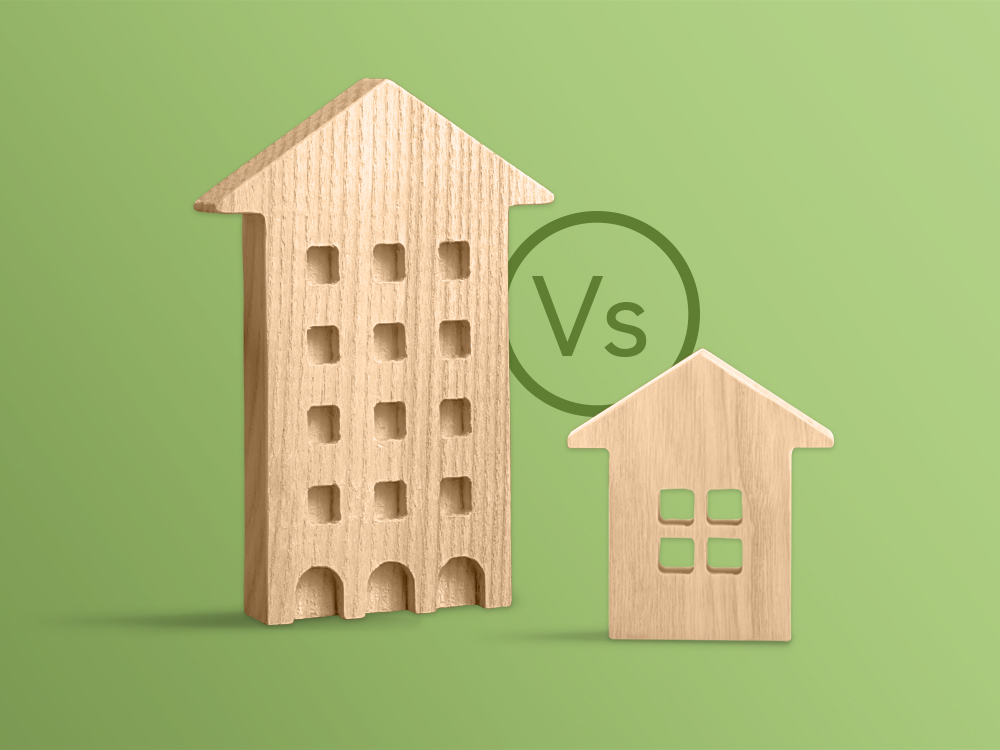Guide to residential vs commercial properties
In general, investors like to stick to either residential or commercial property, with those who are newer to the sector more likely to go for residential.
This makes sense, because anyone who has bought a property to live in knows quite a lot about the process. They can then extend this knowledge into an investment.
Even so, there can be good reasons to invest in commercial property, whether on its own or as part of a semi-commercial or ‘mixed-use’ investment.
By commercial, we mean any property that is used for business, whether it’s a shop, a medical centre, a restaurant or an office.
But what are the main pros and cons of commercial vs residential property investment?

Upsides of commercial investment
Your potential profits may be higher than for residential, thanks to longer lease lengths and higher rates per square metre. Tenancies are usually for several months, if not years, giving you security of income over a longer period, with less ongoing administration.
Commercial tenants are normally responsible for the upkeep of their premises, including renovations and refurbishments, repairs and damage. This can be a major saving, in comparison to residential property, where you may have to mend the roof or fix the boiler.
When you buy a commercial property, you are exempt from the 3 per cent Stamp Duty Land Tax (SDLT) that applies to residential properties bought in addition to a main dwelling. This can be a significant saving, especially in an expensive neighbourhood.
For residential property investors, buying commercial premises is an opportunity to diversify their portfolio, meaning that they receive income from two different asset classes. This can help protect them against a downturn in one or other of the property types.
Lastly, it is now easier to convert some commercial buildings to residential use, thanks to changes in planning laws. In March 2021 the government relaxed rules for changing use from Class E (shops, offices, cafes, restaurants, medical clinics) to Class C (older residential properties providing basic accommodation). You no longer need full planning permission to make this sort of conversion.
As more of these opportunities emerge, property investors are turning to bridging finance providers to support them in converting commercial to residential premises, according to Stephen Clark at bridging finance company Finbri. “In areas of high residential demand such as the Southeast of England, investors have identified major opportunities to reconfigure well-located real estate. Bridging finance can play a very helpful role in bringing these situations to fruition.”
Downsides of commercial property investment
In general, commercial property is more expensive than residential property, so you have to make a larger down-payment. Equally, banks are less willing to lend on the sector, so they demand higher deposits and higher interest payments. A loan-to-value (LTV) of 75 per cent is typically the maximum that a lender will offer on commercial property, compared with 95 per cent on residential.
Although leases are longer than for residential, the initial paperwork and administration in commercial property investment is lengthier and more complex. This itself may be more expensive, as you may have to get legal advice and hire solicitors to draw up contracts. All these expenses add to the risk of the investment.
The advantages of long lease times come with disadvantages: demand for commercial premises is generally lower than for residential and it may take some months to find new commercial tenants for a property, especially during an economic downturn. By contrast, residential tenants are plentiful and can move in quickly.
The move towards working from home, which accelerated during the pandemic, means that certain kinds of commercial premises are suffering from declining demand. Businesses need less office space, people order goods online rather than visiting physical stores. Rising energy bills are also depressing demand for commercial property, as businesses struggle to cover their costs.
You need to be confident that the commercial building you’re buying will still be needed, and profitable to you, well into the future.
What about mixed-use (semi-commercial) property?
There are a whole series of pros and cons connected with mixed-use property. Some investors are highly enthusiastic, others run a mile. Here are the main points:
What’s to love:
Prices are generally lower than for purely residential properties. If you can find a mixed-use building with strong commercial demand, the yield may be a good deal higher than you’d find elsewhere.
(Mixed-use properties generally qualify as ‘commercial’ for tax and legal purposes – that is anything with more than a third of its floor area in commercial use. A three-bedroom property where one room is used as a hairdressing salon would remain residential.)
If you have different tenants for the residential and commercial parts of the building, you spread your risk: there’s less chance of suffering a void period. The commercial tenant pays for the upkeep of their premises, which saves you time and money. And you’re exempt from the 3 per cent extra SDLT that residential investors have to pay. Though bear in mind you'll still have some SDLT to pay.
The option to convert a mixed-use property to purely residential could be very attractive, thanks to recent changes in planning law.
What’s not to love:
Some residential tenants are reluctant to live in mixed-use premises, because of perceived stigma, or the potential nuisance of customers, noises or smells. This may particularly affect you if the commercial part of your investment is a restaurant or a late night bar. They tend to attract younger tenants who are more transient, meaning more administration in replacing them when they leave.
If your lender demands a higher interest rate for a commercial mortgage, this can severely erode your profit margin. Having to pay a higher deposit also ties up money that you might want to spend or invest elsewhere.
Local business and insurance rates are likely to be higher for commercial than residential premises, even though you’re only receiving residential income for part of the building. This again can dent your profits.
Replacing commercial tenants can be a lengthy business, as can selling a mixed-use property.
Final thoughts
There are plenty of reasons not to invest in commercial or semi-commercial property, but wherever there are obstacles there are opportunities.
A lack of competition can lead to bargain prices!
Read next: The guide to buy-to-let
Read the full guide: The guide to property investment
Mini Bridging Loan
Up to £750k available in 3 to 7 days! Our lenders keep fees & fuss to a min using in-house valuations & dual rep solicitors. Suitable for individuals & businesses.
Discover More





